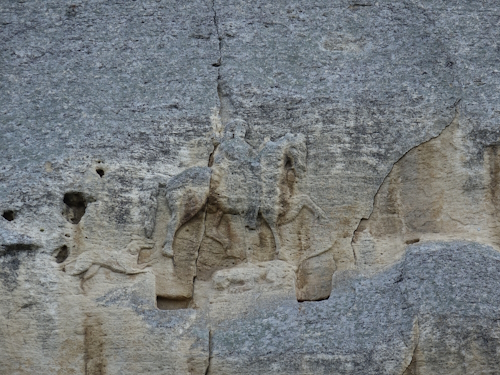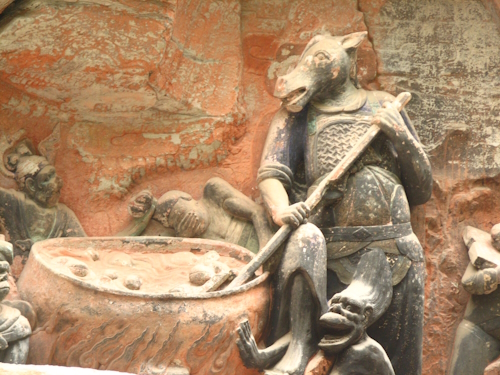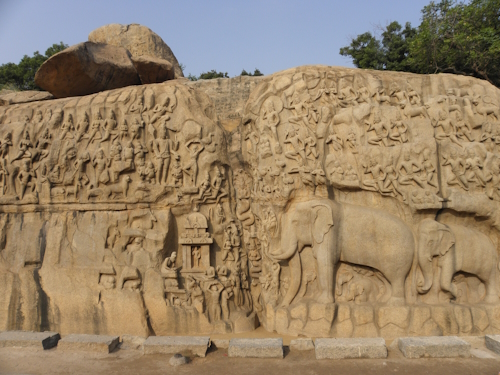Blog Connections
A closer look at Rock Cut Art
Sometimes, while working on the website or prepping for an upcoming trip, I stumble upon an old Connection that hasn’t seen a lot of updates. Often, it’s so old that I hardly remember what it is about. Only Jurre may still know about its existence! While reading up on Göbekli Tepe, I wondered why we don’t have a connection for (bas-)reliefs since they are fairly common occurrences all across the world. It turned out that we are hiding them in a connection called "Rock Cut Art".

Definition issues
I found an e-mail from Solivagant dating back to 2009, where he highlighted that a clear differentiation was needed between the various cultural connections related to the use of “Rock”. We have:
- Monumental Monoliths: heavy pieces of rock, cut and detached from the living rock (including the obelisks of Aksum and Stonehenge).
- Cave Temples/Churches: built into natural caves with possible outside features and carving (such as those in Cappadocia).
- Rock Cut Architecture: structures carved in situ into “living rock”, not primarily based on natural caves (Petra, Ajanta, Ellora, etc).
- Petroglyphs: “line” drawings, patterns, or characters scratched, pecked, or etched into the rock (usually prehistoric, such as Valcamonica).
- And: Rock Cut Art: relief carving of rock which remains “in situ”(= attached to a solid background of the same material), but is not part of Rock Cut Architecture.

Types of Rock Cut Art
A closer look at the currently connected sites under Rock Cut Art reveals that even these 12 are not all that similar:
We have bas-reliefs depicting historical events, in the tradition of the Near East:
- Madara Rider: dating from the earliest years of the establishment of the Bulgarian state, the inscriptions around the relief are a chronicle of important events (photo 1).
- Sassanid Archaeological Landscape: Firuzabad, Fars and Bishapur have groups of Sassanian reliefs, the former including the oldest, a large battle scene.
We have sculpted stones in the Asian-Buddhist tradition:
- Polonnaruva (Gal Vihara): four rock relief statues of the Buddha, which have been carved into the face of a large granite gneiss rock.
- Mount Emei, including the Leshan Giant Buddha: the big Buddha.
- Dazu Rock Carvings: rock reliefs carved into the open rock faces (photo 2).
- Bamiyan Valley: the two monumental Buddhist statues that were carved out of a cliff.
- Gyeongju: 11 relief carvings, of which the most impressive is the Buddha Rock, a massive natural formation in the T’apkol Valley.
- Quanzhou: stone statue of Lao Tze.
And we have miscellaneous others that seem not to belong in this connection:
- Atapuerca (Galeria del Silex): considering the age of the site and the limited extent, I think these should be considered petroglyphs.
- Necropolis of Bet She'arim ("the mother of all menorahs", one of many seven-branched carved stone menorahs found throughout the site): this is interior decoration of rock cut architecture (man-made catacombs).
- Rock Art in the Hail Region (Shuwaymis, "detailed and meticulously pounded figures, of one or two metres are rendered 15–20 mm deep, as bas-relief figures"): usually described as petroglyphs (and are prehistoric).
- Champagne: a series of bas-reliefs by a 20th-century artist in the Pommery cellars, sculpted in the soft chalk of the chalk pits. A modern work of art?
How can we better clarify what this connection is about?
The Rock Cut Art connection has a couple of difficulties:
- The close resemblance to Rock Cut Architecture: although that one is aimed at monumental ‘buildings’ carved into the rock, they often contain a lot of Rock Cut Art as well (both inside and outside). So keeping this connection separate, it will never be a list of the best Rock Cut Art.
- It focuses on a specific technique, and it is hard not to mix it with a certain cultural context. Providing that context (such as the Near East bas-reliefs) may make it clearer.
- The recognizable feature of “relief” is not in the name; Wiki calls them Rock reliefs, and defines them as “generally fairly large, as they need to be to have an impact in the open air”. They include both the Near East and Asian variants.
In addition to “Is it carved out of a rock that is still in situ?”, we could ask for two other distinguishing features: does it show a certain craftmanship (a sculpture) and is it in the open air (aimed to impress passers-by)?

More Rock Cut Art
Based on the refined definition above, I think the following should be added:
- Bisotun: best known for its multilingual text, but it is also a monumental bas-relief that includes an image of King Darius “holding a bow as a sign of sovereignty, and treading on the chest of a figure which lies on his back before him”. It also has a Seleucid reclining Hercules of 148 BC with a Greek inscription.
- The 'Descent of the Ganges' at Mahabalipuram: a large 7th-century Hindu scene with many figures that uses the form of the rock to shape the image (this is a stand-alone monument, not a structural part of the architecture elsewhere on the site). (photo 3)
- Sigirya: the paws at the colossal lion gateway to the hill-palace.
- Hattusa: at Yazılıkaya, a series of reliefs of Hittite gods in procession decorate open-air "chambers".
- El Fuerte de Saimapata: we now have it as part of Rock Cut Architecture, but it is only the part with the intricate carvings that is carved directly out of the natural sandstone bedrock, not the buildings surrounding it.
- Sansa's Beopjusa Temple: a Rock-carved Seated Buddha (now in Rock Cut Architecture, but the temple isn't carved from the rock).
And coming back to Gobekli Tepe …. Here, the "very substantial number of low-reliefs and carvings, mainly of animals" were carved into the T-shaped megalithic pillars that were cut out of a rock elsewhere. So, not "in situ" and, thus, Out.
What do you think of this Connection? Should we rename it, split it, or include it with Rock Cut Architecture?
Els - 6 April 2025
Comments
Els Slots 7 April 2025
Thanks, all! I think it is best to keep the connection but rename it to "Stand-alone Rock Reliefs". I will adjust the list of connections accordingly. Further discussions can be had on the Connections Forum topic.
Frédéric M 6 April 2025
Could Petra qualify for this connection as well? I'm thinking of the camel caravan carved out the Siq. I think it checks all boxes.
Solivagant 6 April 2025
Wieliczka also has "standalone (albeit - subterranean) rock cut art"..... if we ensure that Mines are not included in "Rock cut architecture" (even though they may be "architected" from cutting rock) since the "main goal" of their creation was not to provide "functional space". The Champagne caves were developed initially as quarries for limestone
Jurre 6 April 2025
As I've more or less recently added Champagne to this connection, I did in fact know about this connection. And, just like you, I struggled a bit with the definition and the scope of the connection. A redefinition might help making the connection clearer.
First of all, I don't think it should be included in the "Rock Cut Architecture" Connection, as we have examples of rock reliefs that are not linked to rock-cut architecture.
As for the idea of a split: I'm not sure in which two separate categories we would split the connections. Stand-alone rock reliefs and those connected to rock cut architecture?
I think a redefinition of the connection is the better option. The concept of "Rock reliefs" should be included in the new name, as it distinguishes it from "Rock-cut architecture" and narrows the connection down to reliefs (both haut- and bas-reliefs) as an artistic expression, and distinguishes it from rock inscriptions and carvings (or petroglyphs).
As for what to add to the Connection name:
- If we opt for "Stand-alone", we exclude those reliefs that are part of rock-cut architecture, such as reliefs in rock churches or cave temples. This would exclue the Necropolis of Bet She'arim.
- If we opt for "Open air", then the subterranean rock reliefs, like those in the Necropolis of Bet She'arim and in the Champagne caves, are out.
Personally, I would definitely include the "stand-alone" concept, to exclude those reliefs that are part of rock cut architecture.
I'm in doubt about the "open-air", because I feel the reliefs in the Champagne caves tick several boxes of the rock relief characteristics. They are reliefs, forms of artistic expression. They are stand alone, and not part of rock cut architecture, because the caves were not created with an architectural design. And the reliefs are created to have an impact on the viewer, even if it is underground. It is clearly aimed at the many visitors of the champagne caves. It would make the champagne caves reliefs the exception that proves the rule, as the only subterranean one, but I do feel it ticks a lot of characteristics of rock reliefs.
Els Slots 6 April 2025
After a bit of offline discussion, I would propose a new name for the (separate) Rock Cut Art : "Stand-alone Rock Reliefs" or "Open Air Rock Reliefs"